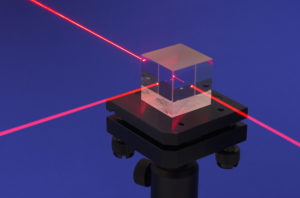Switchable liquid crystal diffractive optical elements

Diffractive optical elements (DOEs) are optical components which are designed to manipulate the spatial distribution of light. Applications of DOEs span across a vast number of industries and include holographic displays, augmented reality (AR) and virtual reality (VR), spectroscopy, aberration correction, beam steering, beam shaping and 3D depth sensing.
Due to their combination of high birefringence and sensitivity to external electric fields, liquid crystals (LCs) are suitable switchable optical materials in spatial light modulators (SLMs) and single-pixel DOEs. Known devices such as LC on Silicon (LCOS) SLMs allow switching between arbitrary pixelated DOE designs with a switching speed of a few ms. However, those pixelated devices are complex and require CMOS backplane electronics to drive the individual pixels of the LC layer.
For many tasks, it is more convenient to use single-pixel LC-DOEs. However, conventional single-pixel devices have a simple device architecture that provides much less flexibility than SLMs, typically only capable of switching between an OFF state and a single ON state.
Technology Overview
Researchers at Oxford have developed an LC DOE that is capable of switching between multiple distinct active states, rather than simply ON and OFF.
The LC layer of the new system includes polymer structures positioned at different depths within the layer. Each polymer structure corresponds to a separate active state. The structures may be used in combination with each other, or independently.
The increased functionality created by having multiple active states is controlled by changing the voltage applied across the device. Complex backplane electronics are not required.
The functionality of this system provides a compromise between fully programmable SLM devices and fixed optical elements. The system also supports multiple modes of operation, for example, conventional-mode operation (optically active by default under no applied voltage) and reverse-mode operation (optically inactive under no applied voltage).
Overall, this system provides opportunities across a wide variety of applications, such as those listed above. The possibility to tune the functionality empowers the developers to create systems suited to many different end uses.
about this technology

